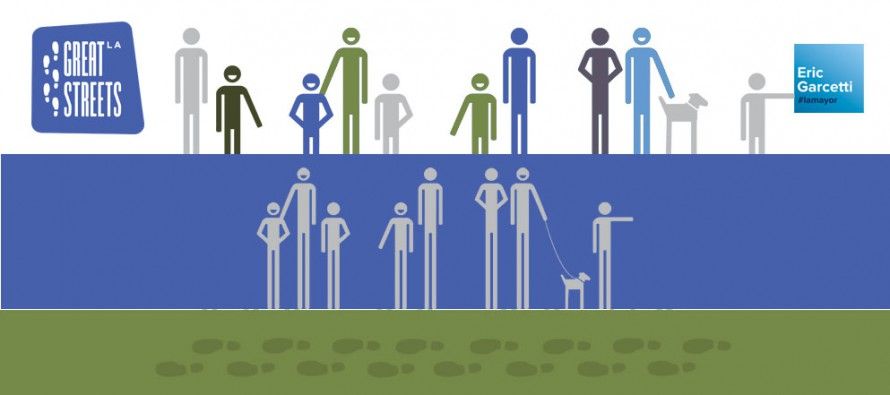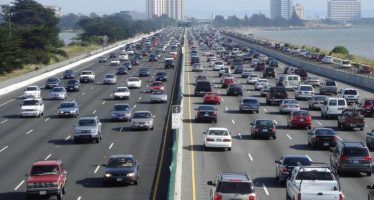LA and SF dogfight over transport visions

 In San Francisco, a bus project over a decade in the making finally receives its massive environmental impact report. In Los Angeles, the mayor announces his first executive directive, launching a “Great Streets” program. It’s a tale of two cities — and two visions of the future of urban planning.
In San Francisco, a bus project over a decade in the making finally receives its massive environmental impact report. In Los Angeles, the mayor announces his first executive directive, launching a “Great Streets” program. It’s a tale of two cities — and two visions of the future of urban planning.
In both San Francisco and L.A., the political leadership harbors a strong interest in moving away from car-first living and working. The similarities and differences between the two cities, however, have set up an important contrast between the policies officeholders wish to use to get there.
Public transportation is already central for many San Franciscans; Angelenos typically rely far more on automobiles. San Francisco is notoriously dense; L.A., famously sprawling. Partly because of those different growth patterns, and partly because of tradition, although San Francisco neighborhoods have their own distinct identity, L.A.’s neighborhoods are bigger, more autonomous, and more self-contained. Residents often choose to spend much of their time near their homes, not shuttling from one side of town to the other unless their work requires it.
Los Angeles, in other words, is relatively distinct among America’s largest cities. Rather than an industrial-age city planned out block by block, constrained by geography, contemporary L.A. is a post-modern patchwork — a veritable network of villages that lacks a single core where residents routinely cluster on foot.
Back to basics for Los Angeles
That’s why many have taken notice of Mayor Eric Garcetti’s “Great Streets” initiative, which is billed specifically as a natural outgrowth of L.A.’s special urban geography and culture. In a speech debuting the program, Garcetti took pains to include “car, bike, foot and transit” among the forms of transportation he hoped to encourage in focusing on revitalizing key L.A. boulevards.
Garcetti has framed the initiative as a showcase of some of his biggest goals as mayor: beefing up both L.A.’s mass transit and its city streets. In describing his would-be legacy, Garcetti told The Washington Post he envisioned Los Angeles as “a place that has a great public transportation system, a world-class airport, that has made a huge dent and is on the way to ending homelessness, that paved its streets and that built up great neighborhoods.”
Relative to San Francisco, augmenting L.A.’s transit system is low-hanging fruit. Garcetti’s most substantial rail project would include improvements to LAX, in particular a new metro line extension. Those plans were recently approved by the board of directors of the Metropolitan Transit Authority, which expects to fund the work with over $300 million raised through sales taxes voted in five years ago under Measure R.
Garcetti has found himself in an unusual political position. In taking over from Antonio Villaraigosa’s largely disappointing tenure, he has been able to focus on smaller, more practical measures than his predecessor. Critics have expressed boredom over his approach, but Garcetti has shown an understanding of its advantages. Having run on a “back to basics” pledge, Garcetti now has the ability to advance projects favored by Democrats, like mass transit, on a scale modest enough to avoid the kind of widespread backlash that Gov. Jerry Brown’s cherished high-speed rail project has attracted statewide.
Red tape for San Francisco
New transportation projects face a different fate in San Francisco. There, a planned bus system upgrade spanning just two miles has racked up an expected cost of $126 million, including associated street modifications. The so-called Van Ness Bus Rapid Transit plan was approved back in 2003 through the city’s Proposition K. The scheme anticipated a 2009 build date. But San Francisco’s bureaucratic hurdles wound up consuming six years and over $7 million; only now has the project received its required environmental impact report, which exceeds several thousand pages in volumes and supplements.
Ironically, the Van Ness project triggered the city’s most demanding level of reportage because arcane rules factor a project’s impact on drive times into the definition of environmental impact. That has environmentalists frustrated — but an upcoming change to California regulations will substitute the drive-time criterion with a so-called “vehicle miles traveled” metric. Environmentalists believe the change will shift the regulatory agenda away from reducing drive delays and toward reducing driving altogether.
It’s a development that could embolden the kinds of urban planners who embrace the currently fashionable vision of cities as centralized, high-density places dependent on mass transit. That, in turn, would likely bring Los Angeles to the fore as proof that cities need not conform to top-down, idea-driven planning in order to update and expand their infrastructure.
Related Articles
California Air Resources Board ratchets up emissions regulations
Continuing a years-long push, the California Air Resources Board cracked down further on emissions, sharpening the debate over the
Rutten's Amazon Attack Ignores Reality
JULY 25, 2011 By JOHN SEILER L.A. Times columnist Tim Rutten continues his tax obsession in “Amazon’s shameful California tax
Premature View On Judge's 'Green' Ruling
FEB. 8, 2011 By WAYNE LUSVARDI Chriss Street’s “CA Judges Get Cold Feet on Warming” (Feb. 7) prematurely celebrates Judges



